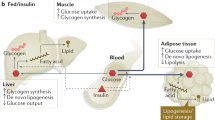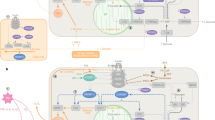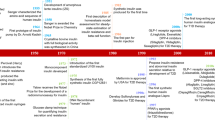Abstract
Obesity is associated with an increased risk of developing insulin resistance and type 2 diabetes. In obese individuals, adipose tissue releases increased amounts of non-esterified fatty acids, glycerol, hormones, pro-inflammatory cytokines and other factors that are involved in the development of insulin resistance. When insulin resistance is accompanied by dysfunction of pancreatic islet β-cells — the cells that release insulin — failure to control blood glucose levels results. Abnormalities in β-cell function are therefore critical in defining the risk and development of type 2 diabetes. This knowledge is fostering exploration of the molecular and genetic basis of the disease and new approaches to its treatment and prevention.
This is a preview of subscription content, access via your institution
Access options
Subscribe to this journal
Receive 51 print issues and online access
$199.00 per year
only $3.90 per issue
Buy this article
- Purchase on Springer Link
- Instant access to full article PDF
Prices may be subject to local taxes which are calculated during checkout




Similar content being viewed by others
References
Hedley, A. A. et al. Prevalence of overweight and obesity among US children, adolescents, and adults, 1999–2002. J. Am. Med. Assoc. 291, 2847–2850 (2004).
World Health Organization Consultation on Obesity 1–253 (World Health Organization, Geneva, 2000).
Wild, S., Roglic, G., Green, A., Sicree, R. & King, H. Global prevalence of diabetes: estimates for the year 2000 and projections for 2030. Diabetes Care 27, 1047–1053 (2004).
Reaven, G. M. Role of insulin resistance in human disease. Diabetes 37, 1595–1607 1988).
Perley, M. & Kipnis, D. M. Plasma insulin responses to glucose and tolbutamide of normal weight and obese diabetic and nondiabetic subjects. Diabetes 15, 867–874 (1966).
Polonsky, K. S., Given, B. D. & Van Cauter, E. Twenty-four-hour profiles and patterns of insulin secretion in normal and obese subjects. J. Clin. Invest. 81, 442–448 (1988).
Kahn, S. E. et al. Quantification of the relationship between insulin sensitivity and B-cell function in human subjects. Evidence for a hyperbolic function. Diabetes 42, 1663–1672 (1993).
Kahn, S. E. The importance of β-cell failure in the development and progression of type 2 diabetes. J. Clin. Endocrinol. Metab. 86, 4047–4058 (2001).
Moran, A. et al. Insulin resistance during puberty: results from clamp studies in 357 children. Diabetes 48, 2039–2044 (1999).
Buchanan, T. A., Metzger, B. E., Freinkel, N. & Bergman, R. N. Insulin sensitivity and B-cell responsiveness to glucose during late pregnancy in lean and moderately obese women with normal glucose tolerance or mild gestational diabetes. Am. J. Obstet. Gynecol. 162, 1008–1014 (1990).
DeFronzo, R. A. Glucose intolerance of aging. Evidence for tissue insensitivity to insulin. Diabetes 28, 1095–1101 (1979).
Goodyear, L. J. & Kahn, B. B. Exercise, glucose transport, and insulin sensitivity. Annu. Rev. Med. 49, 235–261 (1998).
Chen, M., Bergman, R. N. & Porte, D. Insulin resistance and β-cell dysfunction in aging: the importance of dietary carbohydrate. J. Clin. Endocrinol. Metab. 67, 951–957 (1988).
Wellen, K. E. & Hotamisligil, G. S. Inflammation, stress, and diabetes. J. Clin. Invest. 115, 1111–1119 (2005).
Scherer, P. E. Adipose tissue: from lipid storage compartment to endocrine organ. Diabetes 55, 1537–1545 (2006).
Shoelson, S. E., Lee, J. & Goldfine, A. B. Inflammation and insulin resistance. J. Clin. Invest. 116, 1793–1801 (2006).
Yang, Q. et al. Serum retinol binding protein 4 contributes to insulin resistance in obesity and type 2 diabetes. Nature 436, 356–362 (2005).
Kadowaki, T. et al. Adiponectin and adiponectin receptors in insulin resistance, diabetes, and the metabolic syndrome. J. Clin. Invest. 116, 1784–1792 (2006).
Fain, J. N., Madan, A. K., Hiler, M. L., Cheema, P. & Bahouth, S. W. Comparison of the release of adipokines by adipose tissue, adipose tissue matrix, and adipocytes from visceral and subcutaneous abdominal adipose tissues of obese humans. Endocrinology 145, 2273–2282 (2004).
Mooney, R. A. et al. Suppressors of cytokine signaling-1 and -6 associate with and inhibit the insulin receptor. A potential mechanism for cytokine-mediated insulin resistance. J. Biol. Chem. 276, 25889–25893 (2001).
Perreault, M. & Marette, A. Targeted disruption of inducible nitric oxide synthase protects against obesity-linked insulin resistance in muscle. Nature Med. 7, 1138–1143 (2001).
Weisberg, S. P. et al. Obesity is associated with macrophage accumulation in adipose tissue. J. Clin. Invest. 112, 1796–1808 (2003).
Xu, H. et al. Chronic inflammation in fat plays a crucial role in the development of obesity-related insulin resistance. J. Clin. Invest. 112, 1821–1830 (2003).
Reaven, G. M., Hollenbeck, C., Jeng, C. Y., Wu, M. S. & Chen, Y. D. Measurement of plasma glucose, free fatty acid, lactate, and insulin for 24 h in patients with NIDDM. Diabetes 37, 1020–1024 (1988).
Boden, G. Role of fatty acids in the pathogenesis of insulin resistance and NIDDM. Diabetes 46, 3–10 (1997).
Roden, M. et al. Mechanism of free fatty acid-induced insulin resistance in humans. J. Clin. Invest. 97, 2859–2865 (1996).
Santomauro, A. T. et al. Overnight lowering of free fatty acids with Acipimox improves insulin resistance and glucose tolerance in obese diabetic and nondiabetic subjects. Diabetes 48, 1836–1841 (1999).
Randle, P. J., Garland, P. B., Hales, C. N. & Newsholme, E. A. The glucose fatty-acid cycle: its role in insulin sensitivity and the metabolic disturbances of diabetes mellitus. Lancet i, 785–789 (1963).
Shulman, G. I. Cellular mechanisms of insulin resistance. J. Clin. Invest. 106, 171–176 (2000).
Carey, D. G., Jenkins, A. B., Campbell, L. V., Freund, J. & Chisholm, D. J. Abdominal fat and insulin resistance in normal and overweight women: direct measurements reveal a strong relationship in subjects at both low and high risk of NIDDM. Diabetes 45, 633–638 (1996).
Cnop, M. et al. The concurrent accumulation of intra-abdominal and subcutaneous fat explains the association between insulin resistance and plasma leptin concentrations: distinct metabolic effects of two fat compartments. Diabetes 51, 1005–1015 (2002).
Kahn, S. E. The relative contributions of insulin resistance and beta-cell dysfunction to the pathophysiology of type 2 diabetes. Diabetologia 46, 3–19 (2003).
Fujimoto, W. Y. et al. Preventing diabetes — applying pathophysiological and epidemiological evidence. Br. J. Nutr. 84 (Suppl. 2), S173–S176 (2000).
Maeda, K. et al. Analysis of an expression profile of genes in the human adipose tissue. Gene 190, 227–235 (1997).
Motoshima, H. et al. Differential regulation of adiponectin secretion from cultured human omental and subcutaneous adipocytes: effects of insulin and rosiglitazone. J. Clin. Endocrinol. Metab. 87, 5662–5667 (2002).
Reynisdottir, S., Dauzats, M., Thorne, A. & Langin, D. Comparison of hormone-sensitive lipase activity in visceral and subcutaneous human adipose tissue. J. Clin. Endocrinol. Metab. 82, 4162–4166 (1997).
Montague, C. T. & O'Rahilly, S. The perils of portliness: causes and consequences of visceral adiposity. Diabetes 49, 883–888 (2000).
Kim, S. P., Ellmerer, M., Van Citters, G. W. & Bergman, R. N. Primacy of hepatic insulin resistance in the development of the metabolic syndrome induced by an isocaloric moderate-fat diet in the dog. Diabetes 52, 2453–2460 (2003).
Kloppel, G., Lohr, M., Habich, K., Oberholzer, M. & Heitz, P. U. Islet pathology and the pathogenesis of type 1 and type 2 diabetes mellitus revisited. Surv. Synth. Pathol. Res. 4, 110–125 (1985).
Butler, A. E. et al. β-cell deficit and increased β-cell apoptosis in humans with type 2 diabetes. Diabetes 52, 102–110 (2003).
Chen, C., Hosokawa, H., Bumbalo, L. M. & Leahy, J. L. Mechanism of compensatory hyperinsulinemia in normoglycemic insulin-resistant spontaneously hypertensive rats. Augmented enzymatic activity of glucokinase in β-cells. J. Clin. Invest. 94, 399–404 (1994).
Liu, Y. Q., Jetton, T. L. & Leahy, J. L. β-cell adaptation to insulin resistance. Increased pyruvate carboxylase and malate-pyruvate shuttle activity in islets of nondiabetic Zucker fatty rats. J. Biol. Chem. 277, 39163–39168 (2002).
Kahn, S. E. et al. Increased β-cell secretory capacity as mechanism for islet adaptation to nicotinic acid-induced insulin resistance. Diabetes 38, 562–568 (1989).
Kahn, S. E. et al. Effect of exercise on insulin action, glucose tolerance and insulin secretion in aging. Am. J. Physiol. 258, E937–E943 (1990).
Dobbins, R. L. et al. A fatty acid-dependent step is critically important for both glucose — and non-glucose — stimulated insulin secretion. J. Clin. Invest. 101, 2370–2376 (1998).
Prentki, M., Joly, E., El-Assaad, W. & Roduit, R. Malonyl-CoA signaling, lipid partitioning, and glucolipotoxicity: role in β-cell adaptation and failure in the etiology of diabetes. Diabetes 51 (Suppl. 3), S405–S413 (2002).
Bergman, R. N. et al. Why visceral fat is bad: mechanisms of the metabolic syndrome. Obesity 14 (Suppl. 1), 16S–19S (2006).
Itoh, Y. et al. Free fatty acids regulate insulin secretion from pancreatic β cells through GPR40. Nature 422, 173–176 (2003).
Drucker, D. J. The biology of incretin hormones. Cell Metab. 3, 153–165 (2006).
Verdich, C. et al. The role of postprandial releases of insulin and incretin hormones in meal-induced satiety — effect of obesity and weight reduction. Int. J. Obes. Relat. Metab. Disord. 25, 1206–1214 (2001).
Berthoud, H. R. & Jeanrenaud, B. Acute hyperinsulinemia and its reversal by vagotomy after lesions of the ventromedial hypothalamus in anesthetized rats. Endocrinology 105, 146–151 (1979).
Ahren, B., Taborsky, G. J. & Porte, D. Neuropeptidergic versus cholinergic and adrenergic regulation of islet hormone secretion. Diabetologia 29, 827–836 (1986).
Hull, R. L. et al. Dietary-fat-induced obesity in mice results in beta cell hyperplasia but not increased insulin release: evidence for specificity of impaired beta cell adaptation. Diabetologia 48, 1350–1358 (2005).
Sorenson, R. L. & Brelje, T. C. Adaptation of islets of Langerhans to pregnancy: beta-cell growth, enhanced insulin secretion and the role of lactogenic hormones. Horm. Metab. Res. 29, 301–307 (1997).
Bonner-Weir, S., Deery, D., Leahy, J. L. & Weir, G. C. Compensatory growth of pancreatic β-cells in adult rats after short-term glucose infusion. Diabetes 38, 49–53 (1989).
Steil, G. M. et al. Adaptation of β-cell mass to substrate oversupply: enhanced function with normal gene expression. Am. J. Physiol. Endocrinol. Metab. 280, E788–E796 (2001).
Rhodes, C. J. Type 2 diabetes — a matter of β-cell life and death? Science 307, 380–384 (2005).
Bernal-Mizrachi, E., Wen, W., Stahlhut, S., Welling, C. M. & Permutt, M. A. Islet β cell expression of constitutively active Akt1/PKBα induces striking hypertrophy, hyperplasia, and hyperinsulinemia. J. Clin. Invest. 108, 1631–1638 (2001).
Hennige, A. M. et al. Upregulation of insulin receptor substrate-2 in pancreatic β cells prevents diabetes. J. Clin. Invest. 112, 1521–1532 (2003).
Kiba, T. et al. Ventromedial hypothalamic lesion-induced vagal hyperactivity stimulates rat pancreatic cell proliferation. Gastroenterology 110, 885–893 (1996).
Røder, M. E., Porte, D. & Kahn, S. E. Disproportionately elevated proinsulin levels reflect the degree of impaired B-cell secretory capacity in patients with non-insulin dependent diabetes mellitus. J. Clin. Endocrinol. Metab. 83, 604–608 (1998).
Garvey, W. T., Olefsky, J. M., Griffen, J., Hamman, R. F. & Kolterman, O. G. The effect of insulin treatment on insulin secretion and insulin action in type II diabetes mellitus. Diabetes 34, 222–234 (1985).
Kahn, S. E., Bergman, R. N., Schwartz, M. W., Taborsky, G. J. & Porte, D. Short-term hyperglycemia and hyperinsulinemia improve insulin action but do not alter glucose action in normal humans. Am. J. Physiol. 262, E518–E523 (1992).
Sako, Y. & Grill, V. E. A 48-hour lipid infusion in the rat time-dependently inhibits glucose-induced insulin secretion and B cell oxidation through a process likely coupled to fatty acid oxidation. Endocrinology 127, 1580–1589 (1990).
Zhou, Y. P. & Grill, V. E. Long-term exposure of rat pancreatic islets to fatty acids inhibits glucose-induced insulin secretion and biosynthesis through a glucose fatty acid cycle. J. Clin. Invest. 93, 870–876 (1994).
Carpentier, A. et al. Acute enhancement of insulin secretion by FFA in humans is lost with prolonged FFA elevation. Am. J. Physiol. 276, E1055–E1066 (1999).
Utzschneider, K. M. et al. Impact of differences in fasting glucose and glucose tolerance on the hyperbolic relationship between insulin sensitivity and insulin responses. Diabetes Care 29, 356–362 (2006).
Ward, W. K. et al. Insulin resistance and impaired insulin secretion in subjects with histories of gestational diabetes mellitus. Diabetes 34, 861–869 (1985).
Ehrmann, D. A. et al. Insulin secretory defects in polycystic ovary syndrome. Relationship to insulin sensitivity and family history of non-insulin-dependent diabetes mellitus. J. Clin. Invest. 96, 520–527 (1995).
Kahn, S. E. et al. Exercise training delineates the importance of B-cell dysfunction to the glucose intolerance of human aging. J. Clin. Endocrinol. Metab. 74, 1336–1342 (1992).
Cavaghan, M. K., Ehrmann, D. A., Byrne, M. M. & Polonsky, K. S. Treatment with the oral antidiabetic agent troglitazone improves β cell responses to glucose in subjects with impaired glucose tolerance. J. Clin. Invest. 100, 530–537 (1997).
Jensen, C. C. et al. β-cell function is the major determinant of oral glucose tolerance in four ethnic groups in the United States. Diabetes 51, 2170–2178 (2002).
Knowles, N. G., Landchild, M. A., Fujimoto, W. Y. & Kahn, S. E. Insulin and amylin release are both diminished in first-degree relatives of subjects with type 2 diabetes. Diabetes Care 25, 292–297 (2002).
Weyer, C., Bogardus, C., Mott, D. M. & Pratley, R. E. The natural history of insulin secretory dysfunction and insulin resistance in the pathogenesis of type 2 diabetes mellitus. J. Clin. Invest. 104, 787–794 (1999).
Festa, A., Williams, K., D'Agostino, R., Wagenknecht, L. E. & Haffner, S. M. The natural course of β-cell function in nondiabetic and diabetic individuals: the Insulin Resistance Atherosclerosis Study. Diabetes 55, 1114–1120 (2006).
O'Rahilly, S. & Farooqi, I. S. Genetics of obesity. Phil. Trans. R. Soc. B 361, 1095–1105 (2006).
Barroso, I. Genetics of type 2 diabetes. Diabet. Med. 22, 517–535 (2005).
Andrulionyte, L., Zacharova, J., Chiasson, J. L. & Laakso, M. Common polymorphisms of the PPAR-γ2 (Pro12Ala) and PGC-1a (Gly482Ser) genes are associated with the conversion from impaired glucose tolerance to type 2 diabetes in the STOP-NIDDM trial. Diabetologia 47, 2176–2184 (2004).
Kaiyala, K. J. et al. Reduced β-cell function contributes to impaired glucose tolerance in dogs made obese by high-fat feeding. Am. J. Physiol. 277, E659–E667 (1999).
Hales, C. N. & Barker, D. J. Type 2 (non-insulin-dependent) diabetes mellitus: the thrifty phenotype hypothesis. Diabetologia 35, 595–601 (1992).
Leung, N. et al. Prolonged increase of plasma non-esterified fatty acids fully abolishes the stimulatory effect of 24 hours of moderate hyperglycaemia on insulin sensitivity and pancreatic beta-cell function in obese men. Diabetologia 247, 204–213 (2004).
Schwartz, M. W., Woods, S. C., Porte, D., Seeley, R. J. & Baskin, D. G. Central nervous system control of food intake. Nature 404, 661–671 (2000).
Otani, K. et al. Reduced β-cell mass and altered glucose sensing impair insulin-secretory function in βIRKO mice. Am. J. Physiol. Endocrinol. Metab. 286, E41–E49 (2004).
Acknowledgements
This work was supported in part by the US Department of Veterans Affairs and the NIH. S.E.K. is the recipient of an American Diabetes Association Distinguished Clinical Scientist Award.
Author information
Authors and Affiliations
Ethics declarations
Competing interests
The authors declare no competing financial interests.
Rights and permissions
About this article
Cite this article
Kahn, S., Hull, R. & Utzschneider, K. Mechanisms linking obesity to insulin resistance and type 2 diabetes. Nature 444, 840–846 (2006). https://doi.org/10.1038/nature05482
Published:
Issue Date:
DOI: https://doi.org/10.1038/nature05482
This article is cited by
-
The interplay between obesity, immunosenescence, and insulin resistance
Immunity & Ageing (2024)
-
Circulating levels of asprosin in children with obesity: a systematic review and meta-analysis
BMC Endocrine Disorders (2024)
-
Combined versus independent effects of exercise training and intermittent fasting on body composition and cardiometabolic health in adults: a systematic review and meta-analysis
Nutrition Journal (2024)
-
Dietary Insulin Index (DII) and Dietary Insulin load (DIL) and Caveolin gene variant interaction on cardiometabolic risk factors among overweight and obese women: a cross-sectional study
European Journal of Medical Research (2024)
-
Didymin protects pancreatic beta cells by enhancing mitochondrial function in high-fat diet-induced impaired glucose tolerance
Diabetology & Metabolic Syndrome (2024)
Comments
By submitting a comment you agree to abide by our Terms and Community Guidelines. If you find something abusive or that does not comply with our terms or guidelines please flag it as inappropriate.



